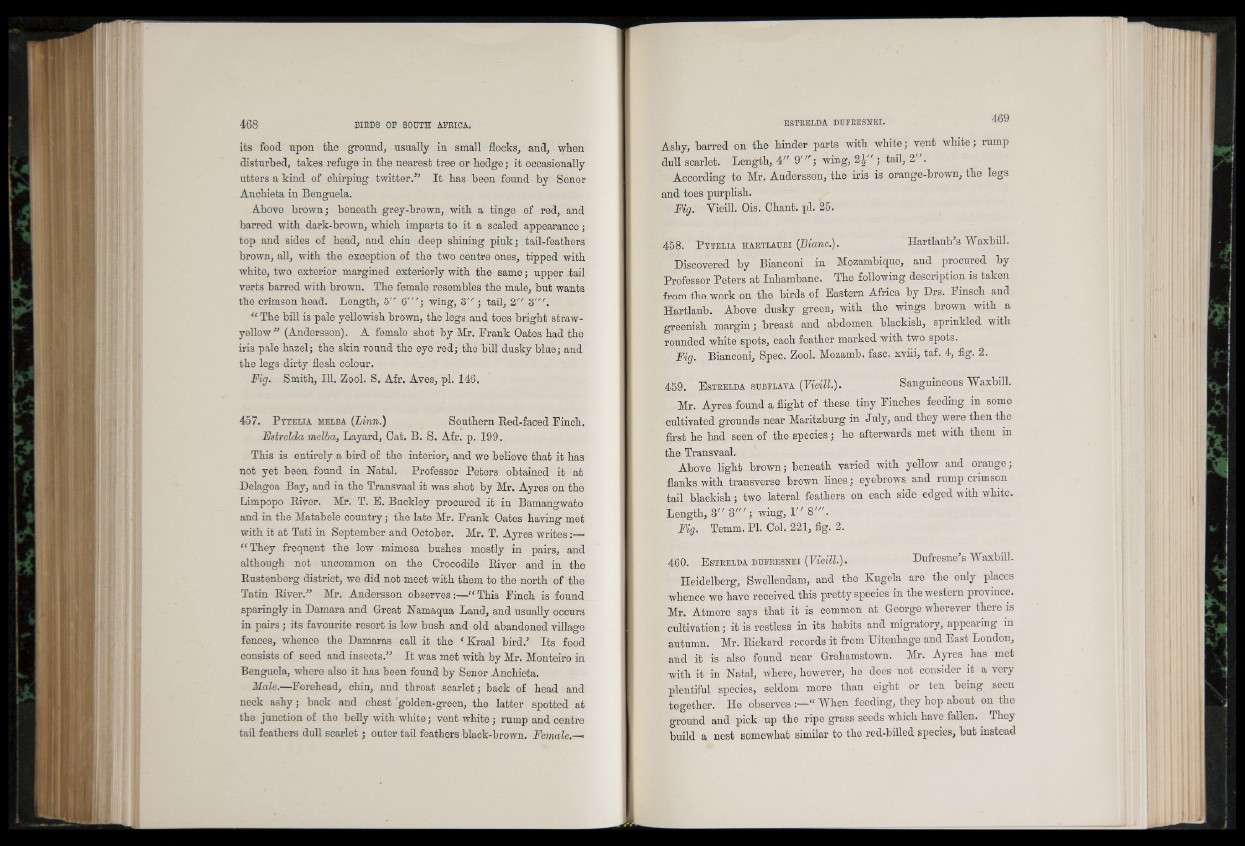
its food upon the ground, usually in small flocks, and, when
disturbed, takes refuge in the nearest tree or hedge; it occasionally
utters a kind of chirping twitter.” It has been found by Senor
Anchieta in Benguela.
A.bove brown; beneath grey-brown, with a tinge of red, and
barred with dark-brown, which imparts to it a scaled appearance;
top and sides of head, and chin deep shining pink; tail-feathers
brown, all, with the exception of the two centre ones, tipped with
white, two exterior margined exteriorly with the same; upper tail
verts barred with brown. The female resembles the male, but wants
the crimson head. Length, 5” Q'"; wing, 3" ; tail, 2" 3'".
“ The bill is pale yellowish brown, the legs and toes bright straw-
yellow” (Andersson). A female shot by Mr. Frank Oates had the
iris pale hazel; the skin round the eye red; the bill dusky blue; and
the legs dirty flesh colour.
Fig. Smith, 111. Zool. S. Afr. Aves, pi. 146.
457. P t t e l ia melba {Linn.) Southern Red-faced Finch.
Fstrelda melba, Layard, Oat. B. S. Afr. p. 199.
This is entirely a bird of the interior, and we believe that it has
not yet been found in Natal. Professor Peters obtained it at
Delagoa Bay, and in the Transvaal it was shot by Mr. Ayres on the
Limpopo River. Mr. T. B. Buckley procured it in Bamangwato
and in the Matabele country; the late Mr. Frank Oates having met
with it at Tati in September and October. Mr. T. Ayres writes:—
“ They frequent the low mimosa bushes mostly in pairs, and
although not uncommon on the Crocodile River and in the
Rustenberg district, we did not meet with them to the north of the
Tatin River.” Mr. Andersson observes:—“ This Finch is found
sparingly in Damara and Great Namaqua Land, and usually occurs
in pairs; its favourite resort is low bush and old abandoned village
fences, whence the Damaras call it the f Kraal bird.J Its food
consists of seed and insects.” It was met with by Mr. Monteiro in
Benguela, where also it has been found by Senor Anchieta.
Male.—Forehead, chin, and throat scarlet; back of head and
neck ashy; back and chest "golden-green, the latter spotted at
the junction of the belly with white; vent white; rump and centre
tail feathers dull scarlet; outer tail feathers black-brown. Female.—
Ashy, barred on the hinder parts with white; vent white; rump
dull scarlet. Length, 4” 9'” ; wing, 2^" ; tail, 2 .
According to Mr. Andersson, the iris is orange-brown, the legs
and toes purplish.
Fig. Yieill. Ois. Chant, pi. 25.
458. P y t e l ia h ar t la ub i (Bianc.). HartlauVs Waxbill.
Discovered by Bianconi in Mozambique, and procured by
Professor Peters at Inhambane. The following description is taken
from the work on the birds of Eastern Africa by Drs. Finsch and
Hartlaub. Above dusky green, with the wings brown with a
greenish margin; breast and abdomen blackish, sprinkled with
rounded white spots, each feather marked with two spots.
Fig. Bianconi, Spec. Zool. Mozamb. fasc. xviii, taf. 4, fig. 2.
459. E strelda subelava (Vieill.). Sanguineous Waxbill.
Mr. Ayres found a flight of these tiny Finches feeding in some
cultivated grounds near Maritzburg in July, and they were then the
first he had seen of the species; he afterwards met with them in
the Transvaal.
Above light brown; beneath varied with yellow and orange;
flanks with transverse brown lines; eyebrows and rump crimson
tail blackish; two lateral feathers on each side edged with white.
Length, 8" 3 '" ; wing, V 8"'.
Fig. Temm. PI. Col. 221, fig. 2.
460. E strelda d u fr e sn e i {Vieill-). Dufresne’s Waxbill.
Heidelberg, Swellendam, and the Kugela are the only places
whence we have received this pretty species in the western province.
Mr. Atmore says that it is common at George wherever there is
cultivation; it is restless in its habits and migratory, appearing in
autumn. Mr. Rickard records it from TTitenhage and East London,
and it is also found near Grahamstown. Mr. Ayres has met
with it in Natal, where, however, he does not consider it a very
plentiful species, seldom more than eight or ten being seen
together. He observes “ When feeding, they hop about on the
ground and pick up the ripe grass seeds which have fallen. ^ They
build a nest somewhat similar to the red-billed species, but instead